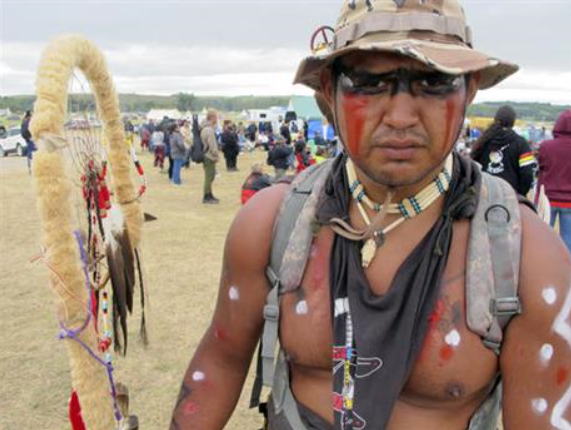By James MacPherson
Associated Press

NEAR THE STANDING ROCK SIOUX RESERVATION, N.D. (AP) — Native Americans from reservations hundreds of miles away from North Dakota have joined the Standing Rock Sioux Tribe’s growing protest against a $3.8 billion four-state oil pipeline that they say could disturb sacred sites and impact drinking water for 8,000 tribal members and millions further downstream.
About 30 people have been arrested in recent weeks and the company has temporarily stopped construction. A federal judge will rule before Sept. 9 on whether construction can be halted on the Dakota Access pipeline, which will pass through Iowa, Illinois, North Dakota and South Dakota.
Meet a few of the people camping out near the confluence of the Cannonball and Missouri Rivers in southern North Dakota:
WAMBLI JOHNSON was supposed to begin third grade last week in northern Arizona’s Black Mesa, on the Navajo Nation. Instead, she rode horses, saw buffalo up close for the first time and made new friends from other tribes.
“This is school,” the soft-spoken 11-year-old who speaks Navajo as her first language said of her experience outside of the 2.3 million-acre reservation.
It was Wambli who persuaded her mother, Osh, to make the daylong drive and join members of nearly 100 tribes and other protesters from around the country after hearing about the protest through relatives and social media.
On Thursday, Wambli presented protest organizers with $150 she earned selling her homemade laundry detergent soap door-to-door in one of the poorest and most remote communities on the Navajo Nation, which spans parts of Arizona, New Mexico and Utah. It took her nearly a month to raise the money, one $2 to $4 soap at a time. Her pitch: “I don’t want water to be poisoned,” she said.
It wasn’t a tough sell, said Wambli, whose own home has no running water and instead has to be hauled in, a chore in which she helps.
“We know water is life,” Osh Johnson said.
___
VIVIAN JOHNSON’s first few years were spent living in traditional Sioux teepee on the Cheyenne River Indian Reservation in north-central South Dakota.
For the past several weeks, the 65-year-old, her four children and seven grandchildren have been making teepees and tents their home at the protest site.
“I’m here to save our water and to save our children,” she said.
Johnson, visibly exhausted, said she intended to stay “as long as it takes” until the pipeline plan is killed.
“It’s a shame it has to be this way.” Johnson said. “I’m tired. And I’m tired of the people fighting over this. I just want peace and this pipeline to go away.”
___
JON DON ILONE REED is no stranger to conflict. The 30-year-old member of the Cheyenne River Sioux Tribe said he answered the call of his country, joining the Army and taking part in a military offensive to drive the insurgents from the late dictator Saddam Hussein’s hometown of Tikrit, Iraq.
“Now, I hear the call of my people,” Reed said of his decision to join the protest.
Imposing but polite, Reed wore a mixture of Army camouflage and traditional tribal dress and his chest bears the scars of a Sun Dance, a sacred — and once illegal — Lakota ceremony. Dancers pierce their bodies with sticks tethered to a tree by ropes. After days of dancing under the sun, the sticks are ripped from their flesh by pulling away from the tree. The dance is a symbol of sacrifice in hopes their creator will hear their prayers.
Reed said he wants the government and the Texas-based pipeline company to hear the pleas of protesters, and prays the protest will remain peaceful.
“I fought in Iraq,” he said. “Now I’m fighting for our children and our water.”
___
JOYE BRAUN, an organizer of the “spirit camp,” has been on site since April 1 — “when there was still snow on the ground.”
“Now we’re getting ready for winter again,” said Braun, a member of the Cheyenne River Sioux Tribe and an organizer with the Indigenous Environmental Network. “We’re not going anywhere.”
She also hopes the protests stay peaceful.
“We’re not against the police at all,” she said. “We’re not against the construction crews — we know they are just trying to make a living. But they are working for the wrong company.”
Braun said the issue is just as much about tribal rights as it is protecting the water and sacred sites. “It will not come through. Period.”




